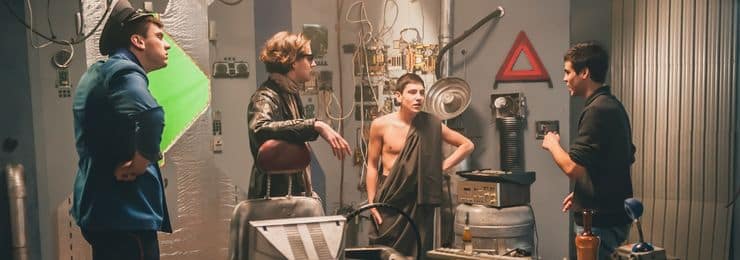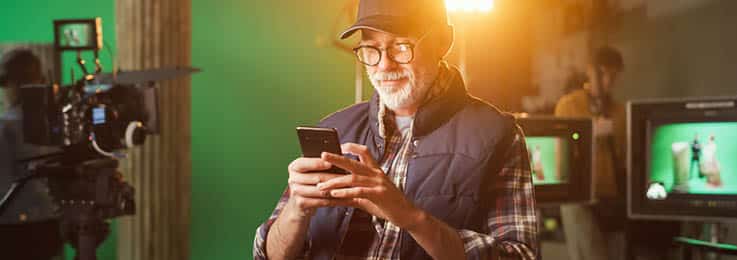Both the director and cinematographer play a key role in the creation and shooting of a film. As crucial presences on a film set, it’s not difficult to imagine these roles being confused inside and outside the film industry.
So, is a cinematographer a director? What does a cinematographer do? In this post, we’ll dive into the reasons why these jobs are not the same, their main roles, and how they work together to bring a vision to life.
In short, a director oversees all aspects of a film’s production, while a cinematographer focuses more on the visual elements. If you’re trying to choose between two of these career paths, learning more about each job and seeing which one aligns with your interests and goals is essential.
Keep reading to learn about how directors and cinematographers have different roles and responsibilities in the production of a film.
1. Roles in Filmmaking
In the film industry, it is widely known who the director is for each film or television program released. They are accepted as the author of the project, with complete creative control over the film.
The director’s role covers all departments involved in making a film, from script changes, and notes to actors, lighting, sound, editing, and costumes. Giving the final approval, a director oversees the overall composition of each scene and how it fits into the final film.

A cinematographer’s role, though on a smaller scale than that of the director, is no less important. They typically lead camera crews and direct shots, angles, and lighting. They may also work under the supervision of a director, who is responsible for the overall artistic vision and image of the film and may receive approval from the director for certain decisions.
For the cinematographer, their attention is fixed on the tone and mood of the film and the quality of each scene. They manage the professionals in the camera, lighting and sound departments, answering to the director.
2. Education
We’ve differentiated the roles of the director and cinematographer, but what are the steps into these vocations?
Both the director and cinematographer are usually required to have at least a Bachelor’s degree. A cinematographer’s degree would be specific, with classes on camera technology and editing.
Whereas directors would complete a general film degree, as they need to be privy to all the goings on in every department. To really stand out in their field, some directors do obtain a master’s degree
Ultimately, experience is the most valued requirement for any director or cinematographer. The more, the better!
3. Experience
A director needs to oversee the whole creative process, and this means gaining experience not just in filmmaking, but in managing people. There is no use in being a fantastic director if you cannot work and coordinate with all departments.
A bonus is if a director has worked in different film departments to ensure they have a clear idea of what each involves.

The cinematographer’s experience, again, must be specific, drawing on skills in lighting, sound, camera, and editing. Due to this, it is thought to be easier to secure a role in cinematography, as you demonstrate specific skills and can work in individual roles, such as a cameraman or sound operator, before moving up to becoming a cinematographer.
Directors, on the other hand, will tend to graduate from film school without prior experience in other film set roles.
4. Salary
As the big cheese on set, directors will tend to earn more than a cinematographer. This is since a director would have been hired to direct a film by a producer or studio who would be handling the finances.
The director would have secured a deal with the producer or studio with a particular salary contracted. If the film grosses past a targeted box office amount, the director could well receive a bonus and royalties following release. The more experience that director has, the higher their potential earnings.
Of course, if a film grosses much less than originally projected, the director could be paid a great deal less. Essentially, the director’s job has the most risk attached in terms of salary.
The cinematographer makes a lot less than the director, but their job holds a much less financial risk. That being said, they tend to need to work consistently throughout the year on multiple projects to ensure their income is steady and sustainable.
5. Job Prospects
With the rise in streaming services and the expansion of the filmmaking industry, the search for directors is always increasing to keep up with audience demand.
Some directors specialize in certain genres or projects so their job prospects can be dependent on the demand for their niche too. Just as the demand for directors rises, this directly affects opportunities for cinematographers.
As we’ve mentioned previously, it is, however, easier for directors to spread their time over many different projects simultaneously. As a cinematographer, there isn’t an opportunity to do that, so they end up focusing on one project at a time.
However, as directors are referred to as the authors of films, they are the first names usually associated with the project, aside from the actors, so studios are more likely to stick to a select few names to promote their projects.
It is harder for directors to break into the industry in the first place. When they do, their name can be the first attached to a project, giving them the most public recognition.

6. Position in the Crew
Once the director and cinematographers have secured their positions on set, both have a high-status role within the project.
The directors are at the top, allowing them the most creative freedom, apart from the producer who is stumping up the funds.
The cinematographer reports to the director who acts almost like a manager to other members of the crew. To support the director, they can hire an Assistant Director depending on the size of the project.
Below the director, the cinematographer is the lead of their own department (camera and lighting crews), feeding ideas and feedback up to the director for discussion and approval.
7. Hiring Privileges
With great power comes great responsibility. The director hires the cinematographer, who then has the responsibility to hire camera crews, and tends to have industry contacts they regularly call upon.
Despite the cinematographer’s hiring powers, the director will still have the final say and can hire anyone they like within the budget. This budget will have been previously signed off by the producer, who in turn hired them.
8. Involvement in Production Meetings
Directors have regular production meetings with the producer to discuss the requirements and expectations of the studio. The cinematographer isn’t required to attend these.
Following these meetings, the director will feed information down to his assistant director (if needed) and his cinematographer, to then be spread to the wider film crew.
It’s a process that is identical to that of any business, with the bosses giving departmental heads information, what is relevant to the wider business, then being distributed accordingly.
So, let’s break down the basic hierarchy of film production:
- Executive Producer
- Director
- Cinematographer
Of course, there are exceptions to this rule, where the Director can be a Director/Producer, as well as many other combinations, such as Director/Writer or even Director/Writer/Producer.
To learn more about the differences between the Producer and Director, why not read our article here.
Well, there we have it.
The director and cinematographer are very different roles than you may have originally perceived. But it’s a partnership that truly brings a film or television show’s vision to life. They are the main collaborators that work together on set to achieve the overall look and tone of what an audience sees on screen.


